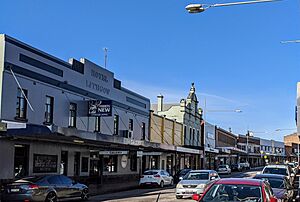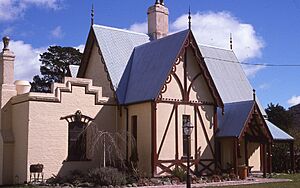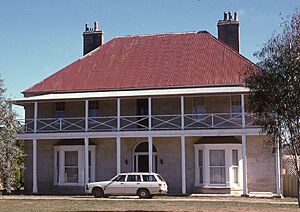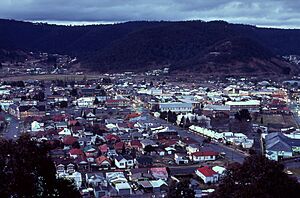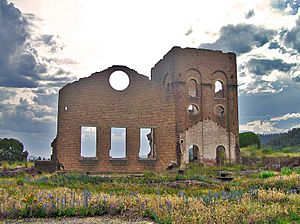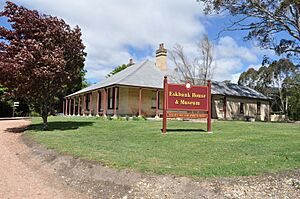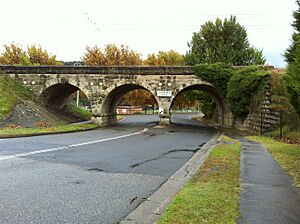Lithgow, New South Wales facts for kids
Quick facts for kids LithgowNew South Wales |
|||||||||
|---|---|---|---|---|---|---|---|---|---|

Aerial view of Lithgow in June 2018, looking west
|
|||||||||
| Population | 20,000 (2020) | ||||||||
| Established | 1870s | ||||||||
| Postcode(s) | 2790 | ||||||||
| Elevation | 950 m (3,117 ft) | ||||||||
| Location | |||||||||
| LGA(s) | City of Lithgow | ||||||||
| County | Cook | ||||||||
| Parish | Lett | ||||||||
| State electorate(s) | Bathurst | ||||||||
| Federal Division(s) | Calare | ||||||||
|
|||||||||
Lithgow is a town in the Central Tablelands of New South Wales, Australia. It is the main town for the City of Lithgow local area. Lithgow is in a mountain valley called Lithgow's Valley. This valley was named by John Oxley to honour William Lithgow.
Lithgow is on the Great Western Highway, about 150 km (93 mi) west of Sydney. You can also reach it by the old mountain road, Bells Line of Road, from Windsor. In June 2021, Lithgow had about 11,197 people living there.
The area around Lithgow has many different landscapes, including seven valleys. These valleys are home to national parks. One of them, the Blue Mountains National Park, is a World Heritage Area. The Wollemi National Park is famous for the Wollemi Pine. This ancient tree, from the time of dinosaurs, was found growing in a hidden canyon in the park!
Contents
Exploring Lithgow's Location
Lithgow is on the western edge of the sandy rock country of the Blue Mountains. Many people think it's the first true country town west of Sydney. Close by are old mining villages like Vale of Clwydd and Oakey Park. Oakey Park was once a famous iron and steel village. Artists have painted many fiery night scenes of it. There are also large areas of bushland and state forests nearby. The next big city to the west is Bathurst, which is about 60 km (37 mi) away.
Lithgow is part of the NSW State election area called Bathurst. For federal elections, it's in the Calare area. Lithgow is also where the electric train line from Sydney ends. It is home to the famous Zig Zag Railway.
Lithgow's Past: A Look at History
The Blue Mountains have very steep terrain. Because of this, building a railway through them was hard. The Lithgow Zig Zag railway was built between 1866 and 1869. It used a special zig-zag shape to climb the mountains. The line opened to Bowenfels in 1869. However, Lithgow station didn't open until 1877.
The Zig Zag was replaced in 1910 by newer tunnels. But parts of the Zig Zag are now a popular tourist attraction. After industries grew in the late 1860s and 1870s, Lithgow became a busy town in the 1880s. It officially became a borough (a type of town) in 1889.
Lithgow is in the middle of a coal mining area. There is a coal-powered power station nearby. Lithgow is also where Australia's first successful steel mill was built. You can still visit the ruins of this old mill at "Blast Furnace Park". Because there is a lot of coal and it's close to Sydney, one of the biggest power stations in NSW, the Mount Piper Power Station, is near Lithgow.
Who Lives in Lithgow?
At the 2021 census, 12,385 people lived in Lithgow.
- About 8.3% of the people were Aboriginal and Torres Strait Islander.
- Most people (82.2%) were born in Australia.
- Other common birthplaces included England (2.2%) and New Zealand (1.1%).
- Most people (86.5%) spoke only English at home.
- The most common religions were No Religion (34.2%), Catholic (20.7%), and Anglican (16.4%).
Historic Places in Lithgow
Lithgow has many places listed for their historical importance. Some of these are on the New South Wales State Heritage Register:
- Bent Street: Lithgow Valley Colliery and Pottery Site
- Brewery Lane: Lithgow Zig Zag
- Gas Works Lane: Lithgow Coal Stage Signal Box
- Inch Street: Lithgow Blast Furnace
- 70 Inch Street: Eskbank House
- Jenolan Caves Road: McKanes Falls Bridge
- Main West Line: Lithgow Underbridge
- Main Western railway: Eskbank railway station
- Main Western railway: Ten Tunnels Deviation
- Railway Parade: Lithgow railway station
- Top Points Zig Zag railway: Cooerwull railway footbridge
Other important sites, once listed on the (now closed) Register of the National Estate, include:
- The old Station Master's Residence, a sandstone house from 1869.
- Eskbank House, built in 1842.
- Lithgow Valley Pottery Site Kiln, used from 1875 to 1908.
- Lithgow Court House, a brick building with an Arts and Crafts style.
- La Salle Cottage (formerly Cooerwull Academy), a stone building from around 1882.
- Methven, a sandstone house built in the 1870s.
- Lithgow Small Arms Factory
Lithgow's Weather and Climate
Lithgow has a moderate oceanic climate. This means it has mild to warm summers and cool to cold winters. It usually gets steady rain all year. Even though it's in the highlands, Lithgow has over 90 clear days each year.
Lithgow is one of the few Australian cities that sometimes sees snow. The snow usually isn't very deep. One big snowfall happened in October 2014, when 20 cm (7.9 in) of snow fell!
| Climate data for Lithgow (Birdwood St, 1912–2006, rainfall to 1889); 950 m AMSL; 33.49° S, 150.15° E | |||||||||||||
|---|---|---|---|---|---|---|---|---|---|---|---|---|---|
| Month | Jan | Feb | Mar | Apr | May | Jun | Jul | Aug | Sep | Oct | Nov | Dec | Year |
| Record high °C (°F) | 37.8 (100.0) |
38.4 (101.1) |
35.1 (95.2) |
30.8 (87.4) |
23.9 (75.0) |
19.5 (67.1) |
19.8 (67.6) |
22.5 (72.5) |
27.6 (81.7) |
33.1 (91.6) |
37.2 (99.0) |
36.8 (98.2) |
38.4 (101.1) |
| Mean daily maximum °C (°F) | 25.5 (77.9) |
24.7 (76.5) |
22.4 (72.3) |
18.4 (65.1) |
14.3 (57.7) |
11.1 (52.0) |
10.4 (50.7) |
12.0 (53.6) |
15.4 (59.7) |
18.7 (65.7) |
21.5 (70.7) |
24.5 (76.1) |
18.2 (64.8) |
| Mean daily minimum °C (°F) | 11.9 (53.4) |
12.1 (53.8) |
10.1 (50.2) |
6.7 (44.1) |
3.9 (39.0) |
1.8 (35.2) |
0.7 (33.3) |
1.3 (34.3) |
3.4 (38.1) |
6.0 (42.8) |
8.1 (46.6) |
10.4 (50.7) |
6.4 (43.5) |
| Record low °C (°F) | 2.8 (37.0) |
3.5 (38.3) |
0.0 (32.0) |
−4.0 (24.8) |
−6.1 (21.0) |
−7.0 (19.4) |
−8.0 (17.6) |
−8.0 (17.6) |
−5.0 (23.0) |
−2.3 (27.9) |
−1.7 (28.9) |
0.6 (33.1) |
−8.0 (17.6) |
| Average precipitation mm (inches) | 94.3 (3.71) |
83.8 (3.30) |
83.8 (3.30) |
62.7 (2.47) |
63.0 (2.48) |
67.3 (2.65) |
67.6 (2.66) |
63.4 (2.50) |
58.9 (2.32) |
67.7 (2.67) |
70.0 (2.76) |
76.1 (3.00) |
861.8 (33.93) |
| Average rainy days | 10.6 | 10.2 | 10.6 | 9.1 | 10.4 | 11.7 | 11.7 | 11.1 | 10.2 | 10.3 | 10.0 | 9.8 | 125.7 |
| Average snowy days | 0 | 0 | 0 | 0.08 | 0.08 | 0.56 | 0.72 | 0.72 | 0.24 | 0.12 | 0 | 0 | 2.52 |
| Average afternoon relative humidity (%) | 54 | 58 | 60 | 59 | 66 | 67 | 66 | 56 | 54 | 51 | 53 | 50 | 58 |
Shopping and Retail in Lithgow
Lithgow has many shops, from small local stores to bigger chains. Some of the well-known stores include:
- Aldi
- Bunnings
- Harvey Norman
- Woolworths
Lithgow also has a main shopping centre called Lithgow Valley Plaza. It has over 500 parking spaces. Inside, you'll find two large anchor stores and more than 30 smaller shops. These include:
- Australia Post
- Coles
- EB Games
- Liquorland
- Target
- The Reject Shop
The Lithgow District Chamber of Commerce helps local shops and businesses. They work to make Lithgow's economy strong. You can also find unique shops and cafes along the main street.
Fun Tourist Attractions in Lithgow
Lithgow is close to many national parks and other cool places to visit. Some popular spots include:
- The Zig Zag Railway
- The Glow Worm Tunnel
- Newnes in the Wolgan Valley
- Glen Davis in the Capertee Valley, which is the second largest canyon in the world.
Other attractions are the Hartley Historic Site, the Lithgow Small Arms Factory Museum, the Lithgow State Mine Heritage Park & Railway, and the Eskbank House Museum. Lithgow is also near Jenolan Caves, which are a World Heritage Area.
A very popular event in Lithgow is Ironfest. This is an annual cultural festival that brings in over 10,000 visitors. Ironfest hosts the yearly St George's Day Jousting Tournament. Knights from all over the world come to compete! The festival also has a historical battle re-enactment called the 'Battle of Lithgow'. Over 120 people dress in 19th-century clothes and act out a battle with cavalry, infantry, and artillery. Besides these historical events, Ironfest features old displays, blacksmith demonstrations, art shows, workshops, and live music.
The Lithgow Greyhound Racing Club started in 1928. Their Saturday race meetings are also a popular attraction. The main event each December is the Lithgow Golden Muzzle.
Media and News in Lithgow
For electronic media, Lithgow has commercial radio stations 2LT and Move FM. These are run by Midwest Radio Network. You can also get public broadcasters like ABC and SBS. Commercial TV networks available include Seven, WIN, and Southern Cross 10. Other channels like 7two, 7mate, 9Gem, 9Go!, 10 Bold, and 10 Peach are also available.
There is a free newspaper called The Central West Village Voice, which comes out every two weeks. The Lithgow Mercury is a newspaper published once a week.
Getting Around Lithgow: Transport
Local bus services in Lithgow are run by Lithgow Buslines.
Lithgow railway station is on the Main Western railway line. It is the end stop for NSW TrainLink Blue Mountains Line services from Sydney. It's also a stop for trains like the Bathurst Bullet, Central West Express, and Outback Xplorer that go to Bathurst, Dubbo, and Broken Hill. From Lithgow, you can also catch bus services to places like Orange, Grenfell, Dubbo, Nyngan, Parkes, and Coonabarabran.
Famous People from Lithgow
Many interesting people have connections to Lithgow:
- Robert Bartlett – a rugby league and lawn bowls player.
- Andrew Brown – the first European settler in Lithgow Valley. He was also an important industrialist and gave a lot to charity.
- Albert Burdus – a rugby league player.
- Cardinal Edward Clancy (1923–2014) – the seventh Roman Catholic Archbishop of Sydney (from 1983 to 2001) was born in Lithgow.
- Joseph Cook (1860–1947) – an English-Australian politician who lived in Lithgow. He was the Sixth Prime Minister of Australia.
- John Doyle – a comedian from the duo Roy & HG, was born in Lithgow.
- Wayde Egan – a rugby league player for the Penrith Panthers and the New Zealand Warriors.
- Roy Heffernan – a professional wrestler, part of The Fabulous Kangaroos, was born in Lithgow in 1925.
- Nancy Hill – a basketball player.
- Marjorie Jackson-Nelson – an athlete and Olympic gold medalist, known as "The Lithgow Flash". She later became Governor of South Australia and grew up in Lithgow.
- Nina Eva Vida Jones (1882–1966) – a socialite and motor racing driver.
- Leon Morris (1914–2006) – a Theologian and New Testament Scholar.
- Laurie Oakes – a journalist, went to Lithgow High School and was the top student in 1961.
- David Palmer – a squash player, was born in Lithgow.
- Ben Reynolds – a rugby league player.
- Marty Roebuck – a former rugby union Wallabies fullback, was born in Lithgow.
- Jordan Shanks – a comedian and YouTuber.
- William John Truscott (1886–1966) – an Australian Rules footballer.



